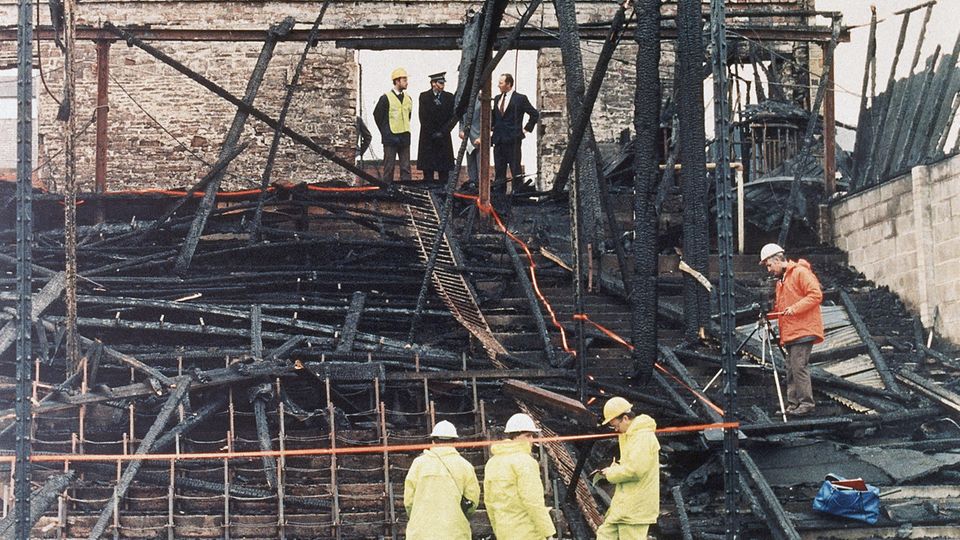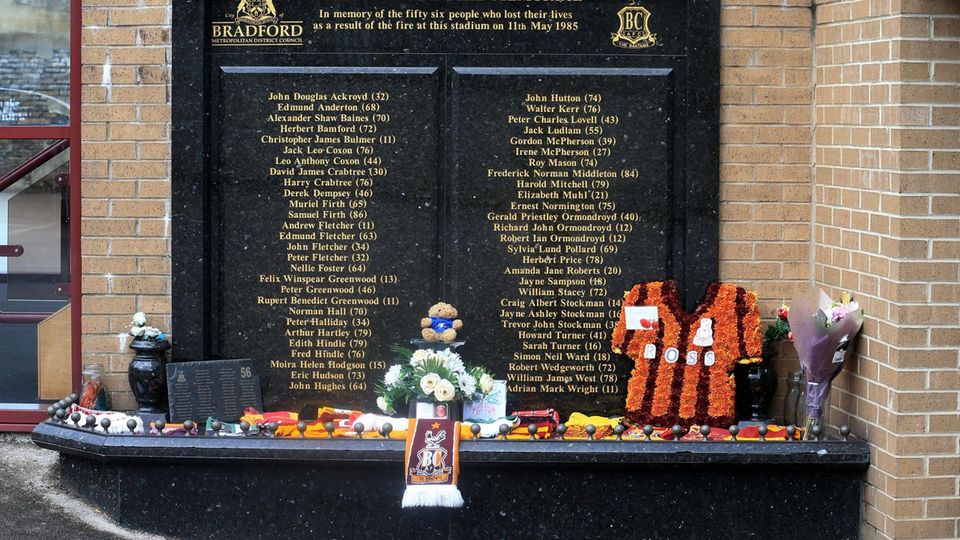May 11, 1985
Bradford City’s fire disaster: when a stadium became a death trap
On May 11, 1985, a fire on the wooden grandstand breaks out in the Valley Parade Stadium in Bradford. The spectators hardly have time to save themselves from the flames. 56 people die.
When Bradford City’s players entered the field on May 11, 1985, the mood could not be more exuberant. With a 2-0 victory against the Bolton Wanderers, they had already brought the Third Division championship title in the penultimate game of the season and had risen to the second division. That was no longer available for 48 years. So today you can appear against the guests from Lincoln City without any pressure. This is one of the reasons why the Valley Parade Stadium in the English county of West Yorkshire with 11,076 spectators is almost sold out that Saturday afternoon. Around 3000 spectators made themselves comfortable on the 80 -year -old wooden stands. The approximately 90 meter long structure is on the slope of a hill. Access takes place via a long corridor, which extends almost over the entire length of the stand-up back. The plans for the new season provide to tear down the old wooden structure and replace it with a steel structure. The wooden terraces are to be replaced by concrete. The carriers for the main grandstand are already ready, right next to the parking lot. Two days after the game, the demolition work should begin for around £ 400,000
As early as July 1984, the club fluttered into the house – from an engineer of the district council. He complained about the accumulation of garbage under the grandstand due to a gap between the seats. There is all sorts of stuff- cigarette and match boxes, plastic cups and bottles, newspapers and chip bags. An carelessly thrown away cigarette could cause a fire disaster here, it is said. That this should occur today – nobody expects that.
At first nobody took the fire from Bradford City seriously
Before kick -off, the players are overjoyed to accept the trophy. What then follows could be called a “tired kick”. Shortly before half-time it is still 0-0 in the Valley Parade Stadium. The game is broadcast live on TV. It is 3:41 p.m. when commentator John Helm noticed the fire in the stands three rows behind Block G. “We actually have a fire in the stands on the other side of the square. And that actually looks very bad.” But none of the spectators notices the tragedy that spreads in front of their eyes. Dave Evans, a Bradford City player, recalls how the fans suddenly become restless in the stands. “We didn’t understand what’s going on.”
Karl Hepton is one of the survivors who remember the day in a TV documentary. The then 9-year-old is in the stadium with his 64-year-old grandmother. “People laughed and sang first, you should pee the fire out. Then they started to move away from the smoke.” The game is interrupted and the fire spreads out rapidly. Fached of gusts of wind, the smoke and the flames shoot across the rows of seats. Because the heat under the wooden roof covered with asphalt plates, there is a so -called firewalk after only two minutes and the wooden roof sealed with asphalt is suddenly explosive. The heat is so enormous that it can be felt throughout the stadium. Burning wood and melted materials fall from the roof to the audience who hardly have time to get to safety.
We remember the 56 people that Died & the 265 Injured in the Devastation Fire at Bradford City Stadium on this day in 1985. The disaster led to changes in Fire Safety Standards for UK Stadiums, Including the Banning of Wooden Grandstands. pic.twitter.com/hiznpjclk2
– Tom George (@P_T_GEORGE) May 11, 2019
At this point, our editorial team has integrated content from Twitter / X.
Due to their data protection settings, this content was not invited to protect their privacy.
“Suddenly the smoke spilled like a wave on the back of the stands,” recalls the then 26-year-old police officer Glynn Leesing. “The smoke was biting and like tar. Really thick, black and caustic – simply terrible. We tried to guess the people on the field, but they did not listen to us and ran in panic to the back of the stands. There the corridors are also wrapped in black. Karl Hepton, whose grandmother is desperately trying to escape the back of the stands of the fire hell.
Outputs and turnstile in the stadium are locked with locks
David Hall is that fateful day with his father in the stadium. The old man can no longer go well. Now his son is pushing him to climb over the rows of seats. “He was big and heavy, could hardly breathe. We came down to the standing space section very slowly and cumbersome. It took forever.” Although there is no fence between the stands and the field, but a wall that is higher on the inside than on the side to the square. There are neither steps to climb nor rods to climb up. “Anyone who was physically unable to lift themselves or not pushed over it had no chance,” said Leesing, who, together with his colleagues and stadium visitors, helps as many people as possible over the wall.
On the back of the stands, people panicked to flee over the turnstile and the outputs. But these are locked with padlocks and there are no folders to open them. Many are crawled in the attempt to crawl under the turnstile. In panic, a few strong men throw themselves against the outputs and manage to open some of the doors.
At the top of the stands, Hepton’s grandma continues to fight through the dense, toxic smoke, past a stadium kiosk. “At some point a hand pulled me and my grandmother,” says Karl Hepton. “It was gray and I was able to see the field again for the first time in a felt eternity”. The man hits a window on the front of the kiosk. “My grandma picked me up, let me dangle over the window ledge and let me down to the seats. She told me: ‘Run! Run!’ And I did that too. ” He pulls his scarf in front of his face, pushes his hands under the sleeves of his jacket and jumps over the fold -out seats. “My scalp hurt from the drops of the melted tarpaulin”. He managed to climb the field.

From there, police officers and civilians come tirelessly to help people over the wall. “We always ran back and forth. But to fill up with oxygen and breathe fresh air, you had to cross half the field,” recalls the police chief Terry Slocombe at the time. “At some point you knew that you couldn’t run back to save more people. It was a very painful moment.” This experience also has David Hall, who makes it with his father to the wall. “I climbed over and ran on the field to a police officer and asked him to help me save my father. But he told me it was too late.” He has to watch helplessly how his father is swallowed by the dense smoke and blazing flames.
56 people die, at least 265 are injured
On the field, people struggle like zombies. With some burn hair, parts of your clothes, others hang the skin down into scraps. A man is completely on fire when he goes over the lawn. Almost as if he is going for a walk. A few men immediately plunge on him, suffocating the flames. Although he made it to the hospital, he later succumbed to his serious injuries – like so many others. At 3:48 p.m. – just four minutes after the fire broke out – the grandstand is on fire. Although the fire brigade is immediately there, it comes too late.

56 people lose their lives that day, including eleven children. The youngest victims, three boys, are eleven years old. The oldest victim is an 86-year-old former chairman of the football club. A large part of the dead is found in the rear outputs and the turnstile in the rear center of the stands. Most died of smoke poisoning. Some are still burning in their seats until they are incredibly burned. Others still succumb to their serious injuries in the hospital weeks later.
The police work under lighting until 4 a.m. the next morning to rescue all corpses. With the help of jewelry, remnants of clothing and by checking the tooth remains, they try to determine the identity of the victims. At least 265 people are injured. Most suffer serious burns, sometimes have to endure several operations and lie in the hospital for months. The sympathy for their fate in the population is huge. The club players, trainers and officials regularly visit the survivors in the hospital. The British pair of heirs, Prince Charles and Princess Diana, also speaks courage on site.

However, an investigation commission is busy finding the cause of the devastating fire. She later comes to the conclusion that a thrown away cigarette was responsible. This has sparked the mountains of waste stored under the stands. During cleaning up, the police still find remains of newspapers from 1968 as well as old coins and cigarette packs. On February 23, 1987, the FC Bradford City association was spoken to guilty in a sample process and desching to a claim for damages in the millions. A third of legal responsibility is burdened by the responsible regional authority of West Yorkshire. As a result of the examination, new wooden grandstands are prohibited on all British sports fields and other wooden grandstands that are classified as unsafe are immediately closed. A ban on smoking on such stands is also introduced.
Martin Fletcher, a survivor who loses his father, grandfather, his younger brother and his uncle that day, follows a different theory. Research on his book “Fifty-Six: The Story of the Bradford Fire” published in 2015 revealed that it was not the only fire in connection with the then club boss Stafford Heginbotham. At least eight other fires between 1967 and 1981 are said to have earned around £ 2.74 million insurance sum from various compensation payments. According to Fletcher, he was faced with financial ruin at the time and was unable to pay for the renovation measures necessary for the rise. He does not directly accuse Heginbotham of arson, but asks the question: “How can a person alone be unlucky?”
A fire in a recycling company has triggered a large-scale operation in Paris. Video recordings show the gigantic column of smoke that runs across the city.
Source: Stern
I am Pierce Boyd, a driven and ambitious professional working in the news industry. I have been writing for 24 Hours Worlds for over five years, specializing in sports section coverage. During my tenure at the publication, I have built an impressive portfolio of articles that has earned me a reputation as an experienced journalist and content creator.




